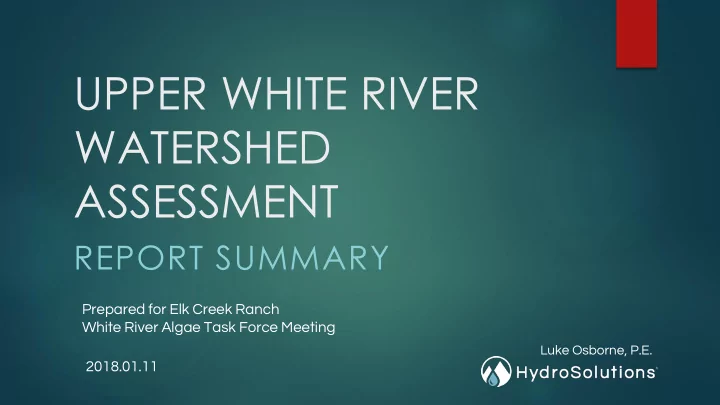

UPPER WHITE RIVER WATERSHED ASSESSMENT REPORT SUMMARY Prepared for Elk Creek Ranch White River Algae Task Force Meeting Luke Osborne, P.E. 2018.01.11
Purpose High-level overview of what we did, our findings, and recommendations Focus on issues relevant to finalizing USGS scope of work Questions & Discussion
Background Began work in July 2017 with Elk Creek Ranch Focus on Upper White River, above Meeker Driving Questions relating to algal blooms: What has changed in recent years? What is the cause and how can we reverse it?
Big Picture Desktop study of existing data Focus on water quality parameters, algal growth indicators, hydrology, and nutrient sources Site visit in late August with deployment of water quality sondes
Summary of Work Literature review Conducted a site visit in late 1. 8. August Reviewed water quality standards 2. Deployed 3 water quality sondes 9. Reviewed CPW data 3. 10. Analyzed hydrology and Identified monitoring sites that 4. streamflow data had sufficient data and monitoring record 11. Nutrient source assessment on an annual basis and for a summer Compiled existing water quality 5. month data 12. Prepared a report Characterized water quality 6. trends and loads Summarized data deficiencies 7.
Summary of Findings No DO impairment No change in water temp pH within min-max criteria (5 th St. Bridge had excursions) Chlorophyll-a data exceeds Colorado standard Total and dissolved N decreasing, P increasing Nitrogen limitation Distinct day-night cycle of pH and DO Multiple hydrologic factors likely affecting blooms Many factors (climate, streamflow, water temp, light) affecting algal growth are beyond control or management Primary tool is nutrient control, few readily controllable nutrient sources in watershed
Data Gaps SAP and QAPP for data collection, validation, and management Adequate laboratory method detection resolution and reporting limits Synoptic monitoring program and spatial coverage of monitoring sites throughout the watershed to assess nutrient source contributions and loads Diurnal monitoring of field parameters DO and pH during peak algal growth Collection of algal/periphyton samples co-located water-quality (nutrient) monitoring Collection of total and dissolved forms of N and P Suspended solids and PAR monitoring Characterization of bed substrate and river transects to form a better understanding of river hydraulic conditions Re-establishment of USGS gaging activities in the North and South Fork White River
Summary of Recommendations Watershed management approach Lead by board or council of stakeholders Define goals and objectives Comprehensive water quality monitoring program to inform sound decisions Implement nutrient source management strategies Focus on nitrogen reductions followed by phosphorus Others detailed in report
Questions & Discussion INDEPENDENT EXPERTISE IN WATER RESOURCES AND THE ENVIRONMENT WWW.HYDROSI.COM | 406.443.6169
Recommend
More recommend